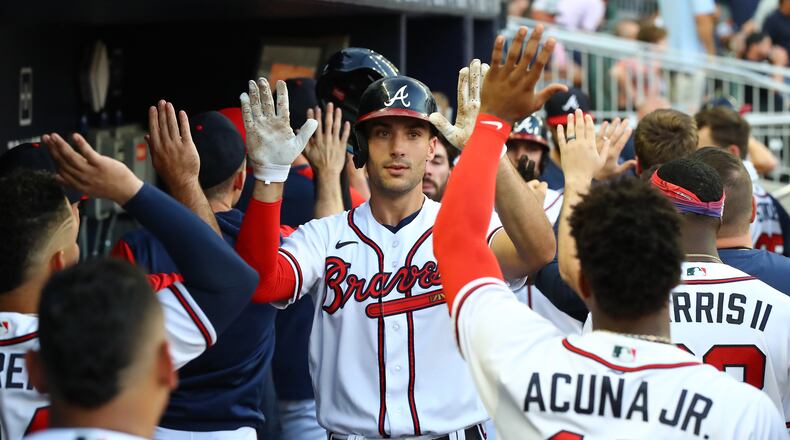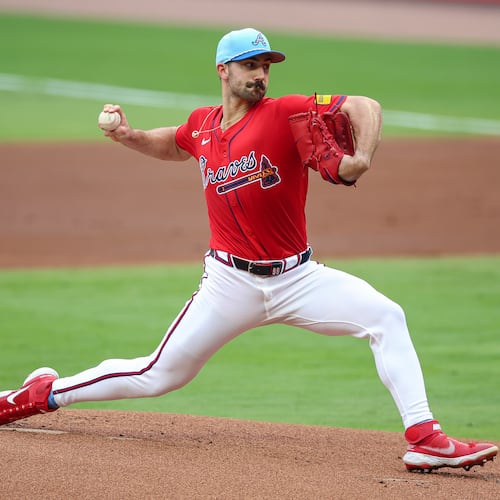As a pitcher, Kyle Wright knows – as well as anyone – about the effects of facing an offense that is dangerous with two outs.
“I feel like it kind of wears you down a little bit,” Wright said. “Usually when you get two outs, especially if you get two quick outs, knowing that, OK, let’s get a quick one here. I feel like with our lineup, even if nobody’s on base, we still have a chance of taking one out of the park real quick with two outs.”
The Braves, to continue what Wright said, make it difficult for pitchers to get that third out. They force opponents to work for it, which has, at least in part, defined their success at the plate this season.
With two outs this season, the Braves lead the majors in many important categories. They rank first in batting average (.262), OPS (.814), hits (206), runs (141) and RBIs (135).
With two outs and runners in scoring position, the Braves rank eighth with a .248 batting average, third with 12 home runs and ninth with 92 RBIs.
This type of production with two outs can be brutal on pitchers. They are trying not only to limit damage, but conserve pitches.
And when an offense is relentless with two outs?
“I feel like it just kind of wears you down a little bit faster just because you’re constantly focused, having to go completely lock in,” Wright said. “I feel like you have to execute all your pitches at all times. Not that you’re not trying to do that anyways, but you have to put a little bit more focus on there. It just really makes it tough to navigate the lineup and go deep into a game, just because you feel like you’re giving it everything you got every single pitch.”
In the first month and change of the season, the Braves’ offensive inconsistency held them back. They often couldn’t get enough of their bats going at the same time.
Things have changed.
“It’s very important,” Braves manager Brian Snitker said of two-out production. “As far as keeping rallies and winning games, you’re probably going to be getting some two-out RBIs.”
The Braves might possess baseball’s best lineup. From Ronald Acuña to Austin Riley to Matt Olson to Dansby Swanson and more, the team features both pop and contact.
But there are other talented lineups in this sport. What separates those who are proficient with two outs?
For one, Wright said, the lineups that are dangerous with two outs in an inning often feature “grinders.
“For me, that’s probably my least favorite guy to face, is the guy that’s just going to grind out at-bats, more so than the guy who’s just got a real good chance of taking you deep,” the righty said.
Wright added this: The Braves have both types of hitters. Some can crank an early pitch for a home run, others can work counts and become difficult outs.
Some of their hitters can do both. It’s a versatile lineup.
As a team, the Braves, entering Wednesday, had seen 3.92 pitches per plate appearance. That’s around the National League average. Olson led the club with 4.21 pitches per plate appearance, followed by Swanson (4.04) and Acuña (4.02).
Riley leads the Braves with 18 home runs, while Marcell Ozuna has hit 13 of them. Olson and Travis d’Arnaud both have 10. As a team, the Braves rank second in baseball with 105 home runs.
Multiple Braves hitters can change games with one swing. They also feature a lot of annoyingly difficult outs. Opposing pitchers are finding it tough to get the third out of an inning.
Rosario, Matzek approaching rehab assignments
Two key Braves may not be far away from returning to the club.
Eddie Rosario (laser eye procedure) and Tyler Matzek (left shoulder inflammation) are nearing rehab assignments. The thought is that they could begin those about a week from now.
Rosario recently spent some time at Triple-A Gwinnett. He didn’t take swings, but tracked pitches. Matzek had been scheduled to throw a bullpen session Wednesday.
Rosario has not played since April 24. Matzek has not pitched since May 10.
Riley gets a day off
Entering Wednesday, the Braves had played 69 games. Austin Riley had played in 68 of them, with his only off-day coming when he missed one game for the birth of his son, Eason.
Riley was not in Wednesday’s lineup. Snitker gave the third baseman his first true off-day of the season.
The manager said there was nothing of concern happening with Riley. The skipper simply felt this would be a good day for an off-day.
“He got banged up a little bit yesterday, overall game, so just going to give him a day to rest,” Snitker said.
Playoff atmosphere
Through 36 home games, the Braves have hosted an average of 37,673 per game at Truist Park. That ranks third in baseball.
It is only June, but Braves fans have made it feel like somewhat of a postseason atmosphere.
“People are coming out,” Snitker said. “This place has been packed every night. There’s a lot of excitement and energy, and they’ve been good games.”
On the road, Braves fans often have shown up for their team. Those trips also have provided a look at how much the Braves have a home-field advantage compared with some other places they’ve played this year.
“This is a tremendous place to play, and the support of Braves Country, how they come out and support this team, pack this place, it’s awesome,” Snitker said. “It’s great. It’s an added energy-type thing when those guys come out and play. And I’ve said it many times: They appreciate it. It’s a great place to be, and it’s always exciting.”
About the Author
Keep Reading
The Latest
Featured



